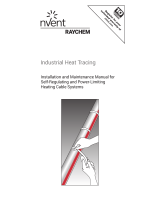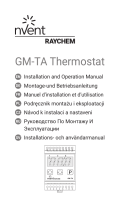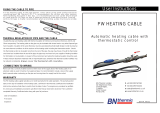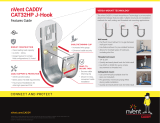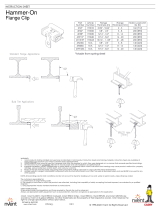Page is loading ...

INSTALLATION AND
MAINTENANCE MANUAL
SELF-REGULATING
HEATING CABLE SYSTEMS

2 | nVent.com
1
General information Pg. 3
2
Heating cable selection Pg. 5
3
Heating cable installation Pg. 5
4
Components installation Pg. 13
5
Thermostats Pg. 18
6
Thermal insulation and marking Pg. 19
7
Power supply and electrical protection Pg. 21
8
Heating cable testing Pg. 21
9
Operation, maintenance and pipe
repairs
Pg. 23
10
Heating cable damage Pg. 24
11
Troubleshooting guide Pg. 24

nVent.com | 3
1 GENERAL INFORMATION
The Installation and Maintenance manual is for nVent
RAYCHEM self-regulating and power limiting heating cable
systems on thermally insulated pipes and vessels only.
For information regarding other applications contact your
nVentrepresentative.
BTV & XTV Self Regulating Heating Cables
L
N
• Power output varies with temperature.
As pipe temperature increases, power output decreases.
• At high temperatures, the polymer expands, reducing
the number of the conductive paths, and thus reducing
current ow.
• At low temperatures, there are many conductive paths,
allowing current to ow between the conductors.
Important
For the nVent warranty to apply, the instructions that are
included in this manual and product packages must be
followed. The installation must be compatible with local
requirements applicable to electric heat-tracing systems.
BTV
TC RU C-BE.МЮ62.В.00054/18
ООО “ПРОММАШ ТЕСТ”
1Ex e IIC T6 Gb X
1Ex e mb IIC T6 Gb X
Ex tb IIIC T80°C Db X
Ex tb mb IIIC T80°C Db X
XTV
TC RU C-BE.МЮ62.В.00054/18
ООО “ПРОММАШ ТЕСТ”
1Ex e IIC T* Gb X
1Ex e mb IIC T* Gb X
Ex tb IIIC T* Db X
Ex tb mb IIIC T* Db X
Certicate
No
Marking

BTV XTV
Minimum Bending Radius
–60°C ≤ T < –20°C 35 mm 51 mm
–20°C ≤ T < –10°C 30 mm 35 mm
–10°C ≤ T < 0°C 25 mm 25 mm
0°C ≤ T < +10°C 20 mm 20 mm
T ≥ +10°C 12 mm 12 mm
Minimum Installation Temperature –60°C –60°C
Warning
As with any electrical equipment or wiring installation operating at line voltages, heat-
ing cable and component damage or incorrect installation that allows the penetration
of moisture or contamination can lead to electrical tracking, arcing and potential re
hazard.
Do not connect heating cable conductors together or this will result in a short circuit.
Any unconnected heating cable end must be sealed with a nVent approved end seal.
To prevent re or explosion in hazardous areas, verify that the maximum sheath
temperature of the heating cable is below the auto-ignition temperature of the gases
in the area. For further information, see design documentation.
BTV XTV
Maximum Maintain Temperature
(power on)
65°C 120°C
Maximum Exposure Temperature (1000
hrs cumulative exposure power on)
85°C 250°C (*)
Maximum Exposure Temperature
(continuous power off)
– –
Self-limiting Temperature in accordance
with EN62086-1 5.1.11
T6
T3
(T2: 20XTV2)
Power Limiting Temperature
(*By design)
– T*
(*) The 250°C rating applies to all products printed “MAX SHORT-TERM EXPOSURE
250С”.
4 | nVent.com

2 HEATING CABLE SELECTION
Check the design specication to make sure the proper
heating cable is installed on each pipe or vessel. Refer to nVent
product literature and the TraceCalc software to select the
proper heating cable for each thermal, chemical, electrical and
mechanical environment.
3 HEATING CABLE INSTALLATION
• Warning
De-energise all power circuits before installation or servicing
Heating cable storage
• Keep ends of heating cable and kit components dry before
and during installation
• Temperature range: –40°C to +60°C
• Protect the heating cable from mechanical damage
Storage and transportation of the heating cable should be
carried out in accordance with GOST 18690-82
3.2 Pre-installation checks
Check materials received:
• Review the heating cable design and compare the list of
materials to the catalogue numbers of heating cables and
electrical components received to conrm that proper
materials are on site. The heating cable type is printed on its
outer jacket.
• Temperature exposure must not exceed that specied in
nVent product literature. Exceeding these limits will impair
product performance. Check that expected exposure is
within these limits.
• Ensure that the heating cable voltage rating is suitable for
the service voltage available.
• Do not energize cable when it is coiled or on the reel.
• Inspect heating cable and components for in-transit
damage. An insulation resistance test (see section 8) on
each reel is recommended.
Check piping to be traced:
• Ensure all pressure testing is complete and pipework has
nal paint coating.
• Walk the system and plan the routing of the heating cable on
the pipe.
• Check pipework against specication drawing. If different
consult design authority.
• Inspect piping for burrs, rough surfaces, sharp edges etc.
which could damage the heating cable. Smooth off or cover
with layers of glass cloth tape or aluminium foil.
nVent.com | 5

6 | nVent.com
3.3 Heating cable handling
Heating cable handling tips:
• Paint and pipe coatings must be dry to the touch before
heating cable installation.
• When pulling the heating cable, avoid:
– sharp edges
– excessive pulling force
– kinking and crushing
– walking on it, or running over it with equipment
Heating cable pulling tips:
• Use a reel holder that pays out smoothly with little tension.
• Keep heating cable strung loosely but close to the pipe
being traced to avoid interference with supports and
equipment.
• Pay out designed length and mark (i.e. with xing tape) on
cable while still on reel.
• Leave the appropriate amount of heating cable at all power
connection, splice, tee and end seal locations.
(Refer to component installation instructions)
– Add additional heating cable to trace the ttings and
supports or for spiralling as required by the design
specications, or consult nVent product literature for
design.
• Protect all heating cable ends from moisture, contamination
and mechanical damage or other interference if left exposed
before component installation.
3.4 Heating cable attachment recommendations
• The heating cable may be installed straight, spiralled or in
multiple runs as required by the design specication, nVent
product literature or TraceCalc software.
– Do not use metal attachments, vinyl electrical tape or duct
tape as heating cable damage may result.
– Self-Regulating technology allows for the multiple
overlapping of the heating cable on to itself.
• Fix in place with a minimum of two wraps the appropriate
self-adhesive glass cloth tape (see gure 1) or plastic cable
ties at 300 mm intervals and additionally where necessary.
• Plastic cable ties must have a temperature rating that
matches the system exposure temperature.
• The heating cable’s minimum bend radius must not be
exceeded (refer to p. 2)

nVent.com | 7
Bend the cable only in upright position
• The heating cable does not bend easily in the at plane.
Do not force such a bend, as the heating cable may be
damaged.
3.4.1 Straight tracing
• Straight trace the pipe unless the design calls for spiralling
(see 3.4.2).
• On horizontal pipes x on lower quadrant as shown in Figure
1 and not on bottom of pipe.
• To prevent overheating, be sure the location of the power
limiting heating cable is planned so that the active heating
zone will not extend into the component. Read the kit
installation instructions and plan the component location
before permanently attaching the cable to the pipe. Ensure
that the active heating zones are located where heat is
required i.e. on the pipe.
• Thermally insulate and weatherproof to specication.
Figure 1
Glass cloth tape
(typical)
Tight on pipe
Top
Pipe
Thermal
insulation
(typical)
45°
(nominal)
300 mm
nVent attachment tapes:
GT66 Self-adhesive glass cloth tape
General purpose tape. Not for stainless-steel surfaces
or for installation temperatures <4°C.

GS54 Self-adhesive glass cloth tape
Recommended for use on stainless-steel and cupra-
nickel surfaces or for installation temperatures <4°C.
Figure 2
ATE-180 Aluminium tape
Use only if the design requires it.
ATE-180 improves the heat transfer and increases the power
output of the heating cable.
Attach the heating cable to the pipe as shown in Figure 2.
3.4.2. Spiral tracing
• Alternative spiralling methods are shown in
Figures 2a and 2b.
• Only spiral heating cable on pipe when called for by design.
• To prevent overheating, be sure the location of the power
limiting heating cable is planned so that the active heating
zone will not extend into the component. Read the kit
installation instructions and plan the component location
before permanently attaching the cable to the pipe. Ensure
that the active heating zones are located where heat is
required i.e. on the pipe.
Spiral Pitch Table (mm).
NB NPS Spiral Ratio
(mm) (inches) Metres of cable per metre of pipe
1.1 1.2 1.3 1.4 1.5
25 1 250 170 140 110 100
32 11/4 310 210 170 140 130
40 11/2 350 240 190 160 140
50 2 430 300 240 200 180
65 21/2 520 360 290 240 210
80 3 630 430 350 290 260
90 31/2 720 490 390 330 290
100 4 800 560 440 370 330
125 5 990 680 550 460 400
150 6 1180 810 650 550 480
200 8 1520 1050 840 710 620
8 | nVent.com

Example:
For pipe of 80 mm NB (3” NPS) requiring 1.3 metres of heating
cable per metre of pipe, pitch is 350 mm.
Figure 2a
Glass cloth tape
(typical)
Heating
cable
Pipe length
Pipe
Apply glass
cloth tape
before spiralling
cable on pipe
Heating cable length
Wrap loops in
opposite
direction
Tape after
spiralling cable
on pipe
Pitch
Heating cable length = pipe length x spiral ratio
Refer to design specication for spiral ratio
Step 1 Make starting loop as shown
Step 2 Grasp loop and wind around pipe
Step 3 Space evenly and attach to pipe.
Thermally insulate and weatherproof to specication
Figure 2b
Pipe
Heating cable
Glass cloth tape
(typical)
Pitch
Refer to design specication for spiral pitch
Mark the pipe at the spiral pitch or use a simple length gauge
Fix the heating cable as installation progresses
Thermally insulate and weatherproof to specication
3.5 Cutting the heating cable
• Cut the heating cable to length after it is attached to the
pipe. Before cutting it, conrm the tracing allowance as per
Sections 3.3 and 3.6.
• RAYCHEM heating cable can be cut to length without
affecting the heat output per metre.
3.6 Typical installation details
• Typical installation details for xing heating cable to pipe
ttings are shown hereafter.
nVent.com | 9

General notes:
• Trace pipe ttings as shown to allow easy maintenance.
• Consult the design specication or nVent product literature
or TraceCalc software for the tracing requirements for
ttings and supports.
• Follow the recommendations for cutting and stripping
heating cables; they are included in the component
installation instructions.
3.6.1 Valve
Figure 3
The heating cable conguration will
vary for different valve shapes and
heating cable lenghts.
Heating cable
Glass tape
Valve body
Pipe
• Refer to design specication for additional heating cable
length.
• Fix with self-adhesive glass cloth tape.
• Thermally insulate and weatherproof to specication
(including valve stem).
3.6.2 Elbow
Figure 4
Thermal insulation
Pipe
Glass cloth tape
(typical)
Heating cable
10 | nVent.com

• Fix heating cable to outside (long) radius of elbow
• Fix with self-adhesive glass cloth tape
• Thermally insulate and weatherproof to specication
3.6.3 Flange
Figure 5
Heating cable
Pipe Glass cloth tape (typical)
• Additional heating cable is 2-3 times diameter of pipe
(typical)
• Fix with self-adhesive glass cloth pipe
• Thermally insulate and weatherproof to specication
3.6.4 Pipe bar hanger
Figure 6
Glass cloth tape
(typical)
Bar hanger
Weatherproong
Thermal insulation
Pipe
Heating cable
Bar hanger
Sealer
Sealer
Heating cable
nVent.com | 11

– Do not clamp heating cable with support. Heating cable
must be over the support
• No additional heating cable is required for bar or rod pipe
hangers unless called for in the design specication, then
use loop length specied
• Fix with self-adhesive glass cloth tape
Thermally insulate and weatherproof to specication
3.6.5 Pipe support shoe
Figure 7
Side view
Heating cable Pipe
Support shoeGlass cloth tape
(typical)
Pipe
• Refer to design specication for additional heating cable
length
• Fix with self-adhesive glass cloth tape
• Thermally insulate and weatherproof to specication
View from under
12 | nVent.com

4 COMPONENTS INSTALLATION
General notes:
Select the required components from nVent product literature or
use the TraceCalc software.
RAYCHEM component kits (including power connections,
splices and end seals) must be used to satisfy Standards and
Approval Body requirements.
Installation instructions included in the kit must be followed,
including those for preparation of the heating cable conductors
for connections. Before assembly, use the guide given in the
instructions to ensure that the kit is correct for the heating
cable and environment.
– RAYCHEM self-regulating and power limiting heating
cables are parallel circuit design. Do not twist the
conductors together as this will result in a short circuit.
4.1 Components required
• For the installation of all components refer to the relevant
component installation instructions.
• Required for each heating cable run:
Power connection and insulation entry kit
End seal.
• As required:
Splice. Tee-splice. Junction box. Three connection kits and
three insulation entry kits. Accessories (pipe straps, xing
tape, support brackets, labels, etc.).
nVent.com | 13

Thermal insulation
Glass cloth tape
(typical)
Insulation
Entry kit
Splice (as required)
SB-101
Valve
End seal
Heating cable
Thermostat
JBU-100
SB-100
C25-100
Connection kit
IEK-25-04
Insulation entry kit
JBU-100
Junction box for
modular system
Heating cable
Wallmounted
4.2 Typical systems
Figure 8a
14 | nVent.com
nVent.com | 15

T-100
Tee or splice
con nec tion
JBM-100
Integrated power/
tee con nec tion
JBS-100
Integrated power con nec tion
(shown with light)
C-150
Low prole power connection
IEK-25-04
Insulation entry kit
E-100-L
Lighted end seal
E-100
End seal
S-150
Low prole splice
E-150
Low prole
end seal
Figure 8b
16 | nVent.com
nVent.com | 17

4.3 Component installation hints
• On horizontal pipes locate junction boxes below pipe
wherever possible. Pinch out drainhole in the stand when
installing upside down.
• Locate junction boxes for easy access but not exposed to
mechanical abuse.
• Position junction boxes so that power cable and heating
cable entries do not point upwards.
JBS-100-L-EP
Integrated power connection
(with earth plate and light)
• Fix lids in place where access not required.
• Conrm junction box stopping plugs are correct for
application and xed rmly in place.
• Route heating cable from junction box to insulation entry so
as to avoid possible mechanical damage.
– Do not strain heating cable as it exits/enters junction
boxes and insulation entries.
• Ensure heating cable is xed above pipe straps such as used
for junction box support brackets.
• Fix all low prole components (e.g. heatshrink end seals) in
place with self-adhesive glass cloth tape.
5 THERMOSTATS
• In temperature-sensitive applications, thermostatic control
may be necessary. If maximum temperature is a concern,
consult your nVent representative for design assistance.
• Follow the installation instructions supplied with the
thermostat. Use the proper wiring diagram for the heating
cable layout and control method desired.
18 | nVent.com

6 THERMAL INSULATION AND MARKING
6.1 Pre-insulation checks
• Visually inspect the heating cable and components
for correct installation and damage. (See Section 10 if
damaged.)
• Insulation resistance (Megger) testing (as per Section 8) is
recommended prior to covering the pipe with thermal
insulation.
6.2 Insulation installation hints
• Correct temperature maintenance requires properly installed
and dry thermal insulation.
• Thermally insulate and weatherproof to design specication.
• Check insulation type and thickness against the design
specication.
• To minimize potential heating cable damage, insulate as
soon as possible after tracing.
• Check that all pipework, including ttings, wall penetrations
and other areas, have been completely insulated.
• Ensure that heating cable is not damaged during installation
of cladding for example by drills, self tapping screws and
sharp edges of cladding.
• Check that all insulation entry kits are tted correctly and
sealed.
• Ensure that all places where valve stems, support brackets,
thermostat capillaries, etc exit the cladding are sealed.
nVent.com | 19

6.3 Marking
• For power limiting heating cable install label: LAB-I-35 as
shown (typical) in gures 10a & 10b
JB
S
-1 0
0-
II
2
G
EE
x
e
I
I
P
TB
9
7
A
TE
X
1
05
8
U
6
0
0
D
o
n
o
t o
p
en
w
h
i
le
e
n
e
r
g
is
ed
N
i
ch
t
u
n
t
er
S
p
a
n
n
u
ng
ö
f
fn
e
n
N
e
p
a
s
ou
v
r
i
r s
ou
s
t
e
ns
io
n
BT
V
E
E
X d
e
I
I
C
T6
P
T
B
N
r.
Ex-9
5
.D
.10
0
2 X
E
Ex
e
II T6
B
AS N
o
.
E
x 96D
3
1
9
9X
Q
TVR
EE
X
d
e
I
I
C
T4
P
T
B
N
r
.
Ex-
95
.
D.100
3
X
E
Ex
e
I
I
T4
B
A
S
N
o.
E
x
9
6D319
8
X
K
T
V
E
E
X
de
II C
T2
PT
B
Nr.
E
x-95.
D
.
1
0
04
X
E
E
x
e
I
I
2
2
6
°C
(
T
2)
B
AS N
o
.
E
x
96D
3
2
0
0X
4, 8,
12,
1
5
XT
V-T3
E
EX
d
e
I
I
C
T
3
P
T
B
N
r
.
E
x-
95
.D.
1005
X
E
Ex e
I
I
T3
B
AS
N
o.
Ex
9
6
D3
4
35
X
20
XT
V
-
T2
E
E
X
d
e
II C T
2
P
T
B N
r
.
Ex-
9
5.D.
100
5
X
E
Ex e
I
I 250
°C
(T2
)
B
A
S
N
o
.
E
x
9
5
D
3
43
5
X
P
R
551
6
4
7
LAB-I-35
LAB-I-35
Figure 10a
Figure 10b
• The presence of the heating cables shall be made evident
by the posting of warning labels or caution labels (“Electric
Traced”) on the cladding. Labels are to be applied at
maximum 3 meter intervals and on alternate locations along
the circuit.
• Install “Electric Traced” signs along piping at suitable
intervals
(3 m intervals recommended) on alternate sides as a
warning.
• Mark on outside of insulation the location of heating cable
components.
• For XTV and KTV heating cables if T-class compliance
was proven by stabilized design: install LAB-EX-XTV-KTV
aluminium tag at approximately 75 mm from the entry of the
junction box.
+
75mm
-
Figure 10c
20 | nVent.com

7 POWER SUPPLY AND ELECTRICAL
PROTECTION
7.1 Electrical loading
Size overcurrent protective devices according to the design
specication or applicable nVent product literature. If devices
other than those specically identied are used, consult the
nVent representative for the appropriate sizing information.
7.2 Ground fault equipment protection is required for
each circuit
The metal sheath/braid of the heating cable must be connected
to a suitable earthing terminal
7.3 Residual current (earth fault) protection
nVent insists on the use of a 30 mA residual current device to
provide maximum safety and protection. However, where there
is a marked increase in nuisance tripping, a maximum 300 mA
residual current device may be used.
For heating cables installed in a hazardous area, the use
of residual current devices is normally a condition of their
approval.
8 HEATING CABLE TESTING
8.1 Recommendations
nVent recommends insulation resistance test before installing
heating cable; before installing thermal insulation; prior to initial
start-up; and as part of the periodic maintenance.
(see Section 9.2).
8.2 Test method
After completing heating cable installation, the insulation
resistance between the conductors and the braid should be
checked (see Figure 11) using a 2.500 VDC megger. Minimum
readings should be 10 Megohms regardless of the heating
cable length. The installer should record the original values for
each circuit on the installation record sheet (see page 25). If a
thermostat is installed, it should be bypassed.
nVent.com | 21
/


